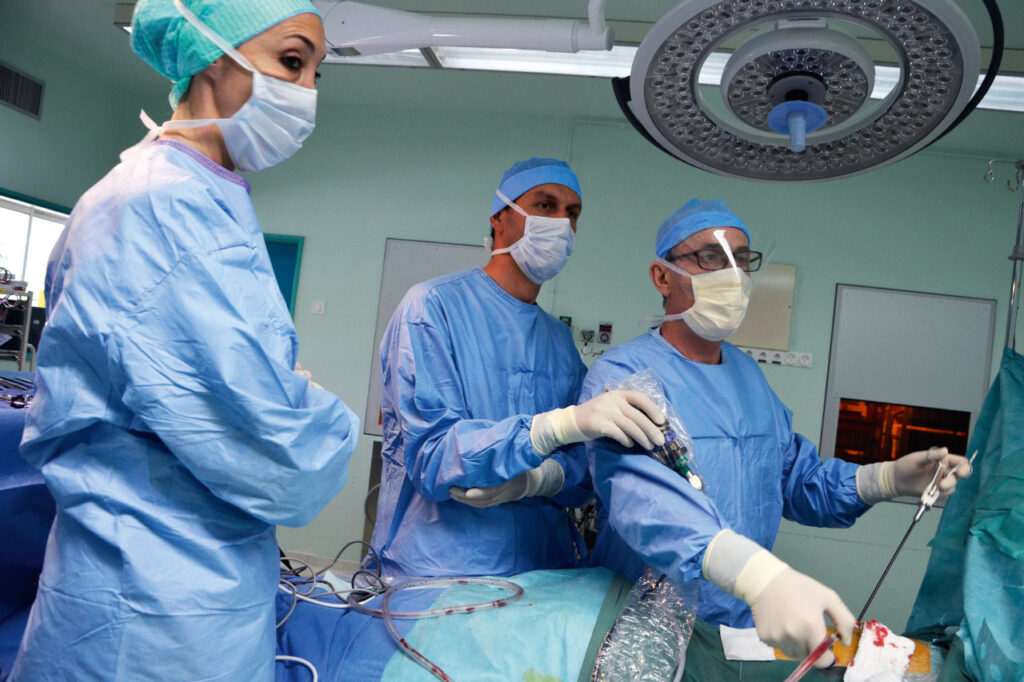[LUM#5] Surgery, sweet surgery
Explorers of the human body, surgeons are seeing their practices evolve thanks to "minimally invasive" surgery: techniques that reduce the drudgery of operations and make life easier for patients.

It's a gentle revolution. It's a surgical technique that offers equally effective procedures, but at a lower cost to the patient. How does it work? Instead of making large openings with the scalpel to expose the organs to be treated, doctors make tiny incisions through which they insert their instruments. The main advantage of this technique is that it reduces surgical trauma and enables the patient to recover more rapidly.
In Montpellier, France, Professor Charles Marty-Ané is a pioneer in the use of minimally invasive surgery to treat lung cancer patients undergoing lobectomy, an operation to remove the lobe of the lung where the tumor is located. To perform this operation in conventional "open" surgery, doctors perform a thoracotomy: the patient's thorax is opened wide so that the doctor can access the lung. " This type of operation causes severe thoracic pain, as the muscles have to be cut, " explains Charles Marty-Ané. This pain can have serious consequences after the operation. " The patient is in so much pain that it's difficult to breathe, and above all he can no longer cough, which prevents the elimination of pulmonary secretions and increases the risk of complications and superinfection ".
Three small holes
The alternative in minimally invasive surgery? Video-assisted thoracoscopy. " Three one-centimeter openings on the side of the thorax, through which instruments and a camera are introduced to provide a panoramic view of the thoracic cavity and guide the surgeon's movements," explains Charles Marty-Ané. The severed lung lobe is then removed through one of the ports, which is slightly enlarged for the occasion. What are the benefits for the patient? " A considerable reduction in post-operative pain and pain-related complications," answers the surgeon. Patients benefit from shorter recovery times, leaving the hospital 2 to 4 days after the operation, compared with 8 to 10 days for thoracotomy. " They resume a normal life more quickly ", stresses the specialist.
In full expansion, thoracoscopic lobectomy is becoming the technique of choice. Although it has developed slowly since its development in 1995, it now accounts for 30% of lobectomies in France. This is still a long way behind countries such as China, Korea, Japan and the United States, where 40% of lung lobectomies are performed using this procedure. However, these countries still lag far behind the thoracic surgery department of Montpellier University Hospital, a true pioneer in this field: " Over the last five years, 74% of lobectomies have been performed thoracoscopically ", explains Charles Marty-Ané(600 closed-chest surgeries performed in Montpellier). This year, his department surpassed the 1,000 mark for this type of operation, giving it an expertise that is unique in France and even in Europe.
Choosing the best solution
While minimally invasive surgery represents a real revolution in the treatment of lung cancer, its advantages are less obvious in other disciplines, notably cardiology. Open" sternotomy surgery, which involves opening the sternum to gain access to the heart, is generally well tolerated by patients, and remains the gold standard in the majority of cases. " To perform minimally invasive surgery, you need a well-trained team and suitable equipment, but above all, you have to select the patients carefully," explains Professor Roland Demaria, cardiac surgeon at Montpellier University Hospital. For the time being, minimally invasive surgery mainly concerns patients in good physical condition whose heart valves need to be repaired or replaced. " In the end, very few patients are eligible for these techniques," emphasizes Roland Demaria.
For the surgeon, the future of the discipline lies in modern interventional cardiology, a hybrid discipline born of close collaboration between surgeons and cardiologists. " This close collaboration enables us to choose the best solution for each patient by discussing each case with the entire medical staff," explains Roland Demaria. Interventional cardiology, for example, makes it possible to replace a failing aortic valve without having to open the patient's chest. "All we have to do is make an incision in the groin and insert a new valve, which is then taken up to the heart via the arterial route. The procedure is much less burdensome for the patient than a conventional operation," stresses the surgeon.
The use of these techniques often enables patients to return home earlier. And patients who leave hospital sooner to return to work are also patients who cost less ( Medico-economic analysis of thoracoscopic lobectomy versus thoracotomy for lung cancer: study protocol for a multicenter randomized controlled trial, in BMJ journals, 2017). " At 1,500 euros per day of hospitalization, the savings for the healthcare system are far from negligible," says Charles Marty-Ané.
UM podcasts are now available on your favorite platforms (Spotify, Deezer, Apple podcasts, Amazon Music...).